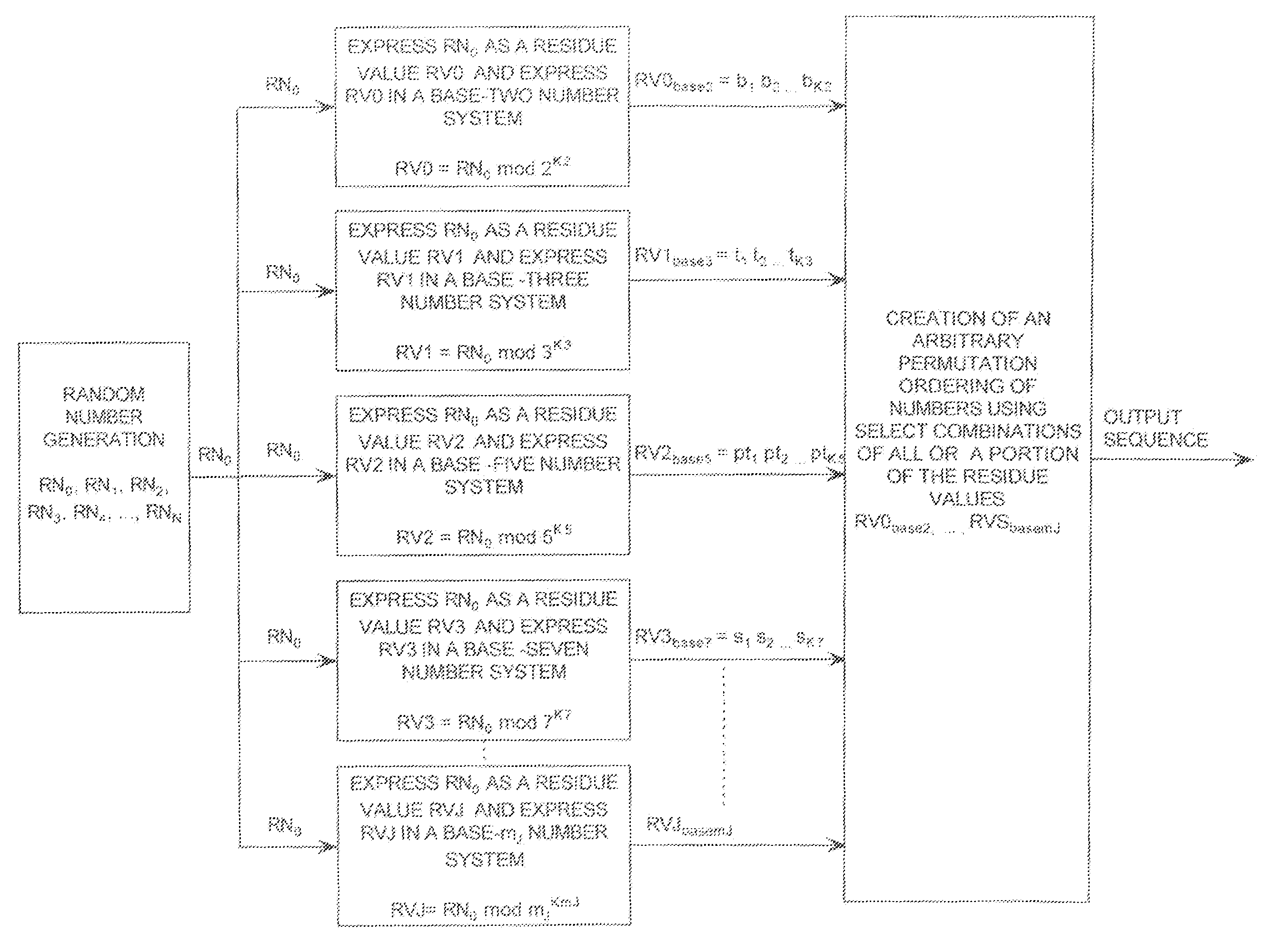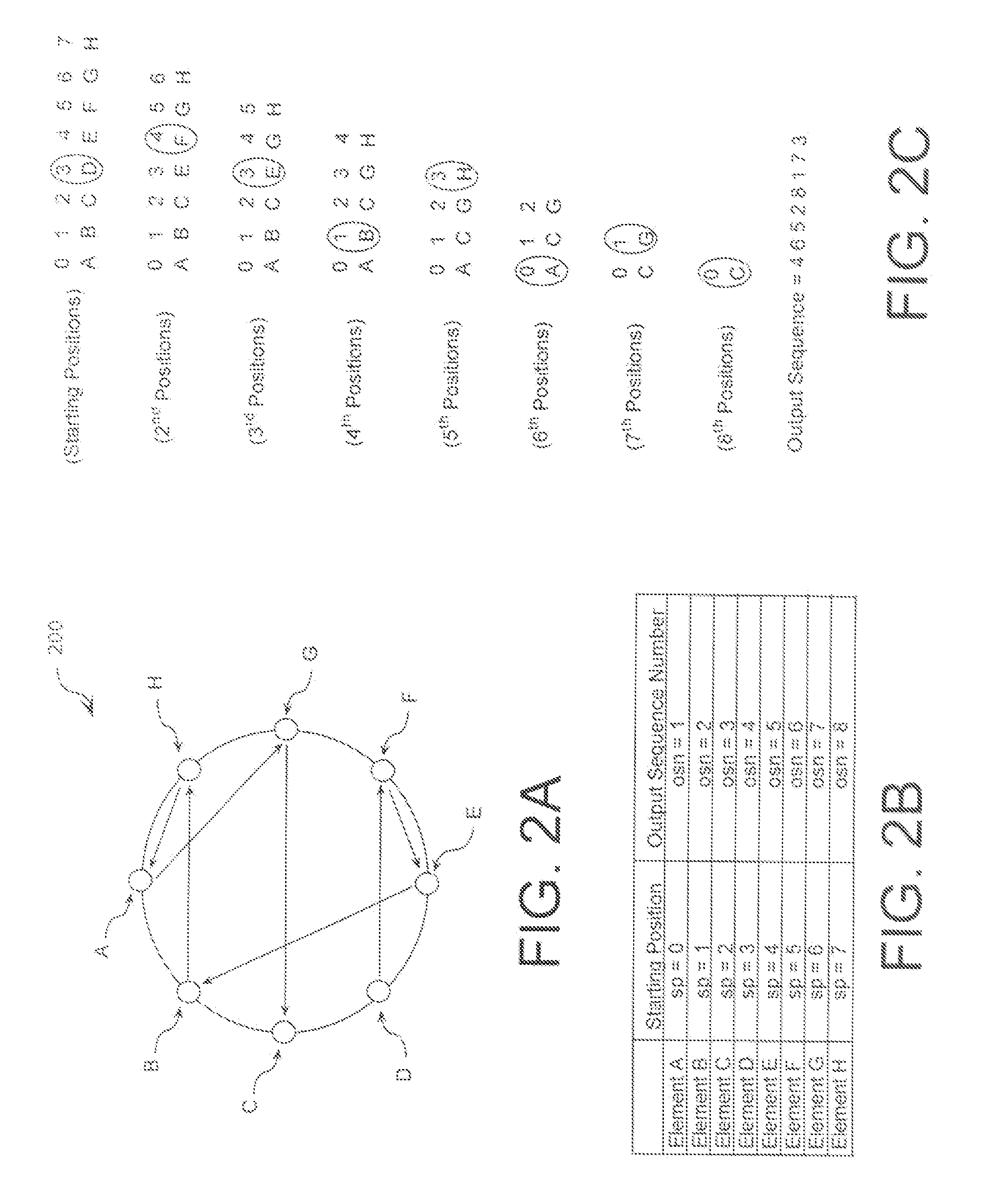Cryptographic system configured for extending a repetition period of a random sequence
a random sequence and repeating period technology, applied in the field of ring generators, can solve the problems of high deterministic orbits, computational inefficiency of computation of elements in odd prime number bases with digital hardware, and certain drawbacks
- Summary
- Abstract
- Description
- Claims
- Application Information
AI Technical Summary
Problems solved by technology
Method used
Image
Examples
example 1
[0053]A random number RN0 can have a decimal value of zero to forty thousand three hundred nineteen (40,319). As such, the total possible values that the random number RN0 can equal is forty thousand three hundred twenty (40,320). Using the Fundamental Theorem of Arithmetic, the number forty thousand three hundred twenty (40,320) can be written as 8!=8·7· . . . ·1=27·32·51·71. In effect, a cyclic structure employed in such a scenario includes n elements, i.e. eight (8) elements.
[0054]Each RNS arithmetic operation employed for expressing the random number RN0 as a RNS residue value RV0, . . . , RV3 uses the relatively prime numbers 27, 32, 51, 71 as the set of moduli m0km0, m1km1, m2km2, m3km3. Accordingly, the RNS residue values RV0, . . . , RV3 can be defined by mathematical Equations (2-5).
RV0=RN0 modulo 27 (2)
RV1=RN0 modulo 32 (3)
RV2=RN0 modulo 51 (4)
RV3=RN0 modulo 71 (5)
[0055]The RNS residue value RV0, . . . , RV3 can be computed by substituting the value of the random numbe...
example 2
[0058]A random number sequence of a size fifty-two factorial (52!) is chosen via any combination of number generation processes. The random number sequence of a size fifty-two factorial (52!) is approximately equal to eight times ten to the power of sixty-seven (8·1067). Using the Fundamental Theorem of Arithmetic, the number eight times ten to the power of sixty-seven (8·1067) can be written as 52!=52·51· . . . ·1=249·323·512·78·114·134·173·193·232·291·311·371·411·431·471. Alternately and more efficiently, a collection of fifteen (15) independent random number generators on each of the number bases can be used equivalently to produce an effective random number of size fifty-two factorial (52!). Following the same logic described above (in relation to FIGS. 1-2 and Example 1), a first number of an output sequence is determined using two (2) base-two digits and one (1) base-thirteen digit. A second number of an output sequence is determined using one (1) base-three digit and one (1) ...
example 3
[0059]A random number generator based on these combinatorial techniques can be constructed using an arbitrary mapping of n=233 elements as in cyclic ring 200, whose output is combined with some number of other cyclic ring generators. This combination may be performed using a method such as the Chinese Remainder Theorem. If the characteristics of the additional cyclic ring generators are odd primes exceeding two hundred thirty three (233), such as two hundred thirty nine (239), two hundred forty one (241), and two hundred fifty one (251), the effective repeat duration increases multiplicatively. Based on the four numbers in this example, the output sequence would only repeat after more than ten to the power of four hundred fifty nine (10459) outputs. Moreover, the incorporation of these additional cyclic ring generators helps mask the deterministic properties of the permutation mapping.
[0060]Referring now to FIG. 3, there is provided a flow diagram of a method 300 for creating an arb...
PUM
 Login to View More
Login to View More Abstract
Description
Claims
Application Information
 Login to View More
Login to View More - R&D
- Intellectual Property
- Life Sciences
- Materials
- Tech Scout
- Unparalleled Data Quality
- Higher Quality Content
- 60% Fewer Hallucinations
Browse by: Latest US Patents, China's latest patents, Technical Efficacy Thesaurus, Application Domain, Technology Topic, Popular Technical Reports.
© 2025 PatSnap. All rights reserved.Legal|Privacy policy|Modern Slavery Act Transparency Statement|Sitemap|About US| Contact US: help@patsnap.com



